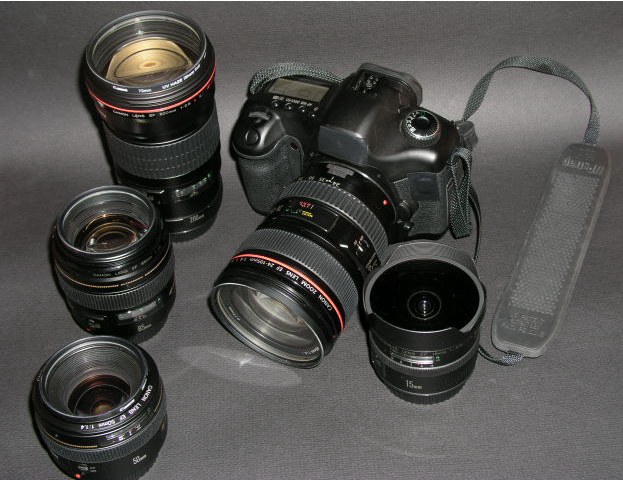15 months later
Click on my profile and you will see that the revenue I generate from this journal is zero. Zilch. Nothing. No ads, no banners, no conflicts of interest. When I write that something is good, it’s based in actual experience, not desire to generate click-through dollars. If the modest revenue I forego is the cost of full disclosure, well, it’s worth every penny. When I write that it’s bad, well, that’s because it is.

My outfit today. 5D, 24-105mm f/4 L, 200mm f/2.8, 85mm f/1.8, 50mm f/1.4, 15mm fisheye, aftermarket strap
So, some 15 months after buying my Canon 5D, what is good and what is bad? Recalling the original reasons for purchase, the primary drivers were to replace my bulky, clunky, heavy medium format gear, primarily used for landscape photography. Rollei SLR, Rollei TLR, Mamya 6 rangefinder. That the 5D accomplished with ease. A related benefit was that the body ended up replacing all my 35mm equipment as well, as the trade-offs against the rangefinder Leicas I had been using for 35 years worked well for me.
So let’s get the bad things, the design errors and compromises, out of the way first.
- The LCD screen is unusable in sunlight. If you need to change most settings, find a shady spot.
- The camera is bulky – you think twice before taking it with you, compared to four times with film-based medium format gear.
- The sensor attracts dust quicker than socialism attract losers.
- The viewfinder readouts are useless in bright sun. So try to change ISO (which is meant to be visible in the finder and the top panel) and you have to once again resort to that shady spot.
- The egonomics are so-so. The camera feels great in my (largish) hands but the plethora of small buttons is an abomination. Canon needs, as a minimum, to move ISO (a very frequently used control with the grainless 5D sensor) to a good old-fashioned, click stopped dial visible to all, not some minute set of digits on a useless LCD screen or a hard to read panel on top.
- It could be quieter, though it’s a church mouse compared to a Nikon F, say.
- The less said about the factory strap, the better.
- Matrix focusing is a problem looking for a problem. Inept at best. I use the center rectangle focus area only.
- Garish product names on the camera – black electrician’s tape fixed that.
- The price remains far too high, owing to the absence of competition.
- IS in selected lenses only, rather than in the body, where it belongs.
- Not as well made as the early Leica M2/3/4, but what is?
A long list, written by a grumbler obsessed with the man-machine interface.
But there’s lots of good things, several probably unique.
- It does not use film. No more processing scratches, endless scanning, the nightmare of waiting for results.
- That magnificent, grain free, sensor. Use RAW and the dynamic range is comparable to the best film can offer, so long as you expose for the highlights, not the shadows. The sensor has a nasty tendency, seemingly common in digital, to burn out highlights.
- 18″ x 24″ prints on my HP DJ90 easily equal anything the best medium format gear had to offer, and with a far greater success rate. Compared to 35mm film there is simply no contest.
- Critically accurate auto focusing with that central rectangle, superior to anything a well tuned optical rangefinder can offer.
- Outstanding, definition improving, IS in the 24-105mm Canon lens (the only IS lens I own, so I cannot speak for others). Worth two shutter speeds.
- Small file sizes – some 12mb if you use RAW.
- Nice, large CF cards for image storage – something this human being can easily grasp. By contrast the SD cards used by many are simply too physically small to be handled with ease, even if their storage capacities are comparable.
- Dirt cheap, superb lenses (and that goes for the ‘L’ and non-‘L’ ones in my little outfit) – that is for someone coming from the Rollei SLR and Leica rangefinder worlds. Optically good enough that the price premium for German lenses no longer makes sense.
- Replaces both medium format and 35mm film gear, with a huge attendant reduction in bulk and weight.
- Excellent selection of metering modes includes a really accurate spot metering variant.
- Breathtakingly fast autofocus with my five Canon lenses. Beyond anything you could possibly accomplish with any manually focussed camera. With the 200mm f/2.8 you have a camera whose optical qualities surpass even those of my old Leicaflex SL and the magnificent Leica Apo-Telyt-R 180mm, f/3.4 lens.
- Excellent battery life – easing the worries that the prospect of dead batteries brings.
- Free, if you sell all that Leica gear to Japanese collectors like I did.
Would I buy it again today at the US price of $3,799 with the 24-105mm ‘L’? That’s some 13% less than I paid fifteen months ago. Yes, but I would still grumble at the price. With the 30D body selling for $1,600, compared to the $2,800 for the 5D, the $1,200 premium is simply too high for the sole distinguishing factor of a full frame sensor. At $2,000-$2,200 the price smells about right, and it would quickly get there were someone at Pentax, Nikon, Olympus or Sony to pull their finger out and offer a full frame competitor.
Your blog is a fantastic resource. Thank you very much for keeping this up and posting such valuable information!
Thanks, Thomas. I have one en route. Long overdue, I must say. Decided to blow the budget and keep the Leicas, if only to assuage my fixation with minimalist design and ergonomics.